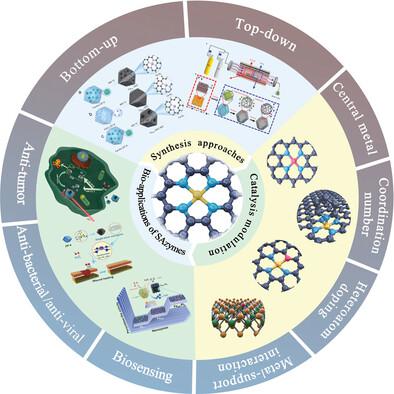当前位置:
X-MOL 学术
›
Adv. Mater.
›
论文详情
Our official English website, www.x-mol.net, welcomes your
feedback! (Note: you will need to create a separate account there.)
Current Advances on the Single-Atom Nanozyme and Its Bioapplications
Advanced Materials ( IF 27.4 ) Pub Date : 2023-02-11 , DOI: 10.1002/adma.202211724 Chao Peng 1 , Ruoyu Pang 1, 2 , Jing Li 1, 2 , Erkang Wang 1, 2
Advanced Materials ( IF 27.4 ) Pub Date : 2023-02-11 , DOI: 10.1002/adma.202211724 Chao Peng 1 , Ruoyu Pang 1, 2 , Jing Li 1, 2 , Erkang Wang 1, 2
Affiliation

|
Nanozymes, a class of nanomaterials mimicking the function of enzymes, have aroused much attention as the candidate in diverse fields with the arbitrarily tunable features owing to the diversity of crystalline nanostructures, composition, and surface configurations. However, the uncertainty of their active sites and the lower intrinsic deficiencies of nanomaterial-initiated catalysis compared with the natural enzymes promote the pursuing of alternatives by imitating the biological active centers. Single-atom nanozymes (SAzymes) maximize the atom utilization with the well-defined structure, providing an important bridge to investigate mechanism and the relationship between structure and catalytic activity. They have risen as the new burgeoning alternative to the natural enzyme from in vitro bioanalytical tool to in vivo therapy owing to the flexible atomic engineering structure. Here, focus is mainly on the three parts. First, a detailed overview of single-atom catalyst synthesis strategies including bottom-up and top-down approaches is given. Then, according to the structural feature of single-atom nanocatalysts, the influence factors such as central metal atom, coordination number, heteroatom doping, and the metal–support interaction are discussed and the representative biological applications (including antibacterial/antiviral performance, cancer therapy, and biosensing) are highlighted. In the end, the future perspective and challenge facing are demonstrated.
中文翻译:

单原子纳米酶及其生物应用研究进展
纳米酶是一类模仿酶功能的纳米材料,由于晶体纳米结构、成分和表面构型的多样性,具有任意可调的特性,作为多种领域的候选材料引起了广泛的关注。然而,与天然酶相比,其活性位点的不确定性以及纳米材料引发的催化的内在缺陷较低,促进了通过模仿生物活性中心来寻求替代品。单原子纳米酶(SAzymes)以其明确的结构最大限度地利用原子,为研究机制以及结构与催化活性之间的关系提供了重要的桥梁。由于灵活的原子工程结构,它们已成为天然酶的新兴替代品,从体外生物分析工具到体内治疗。这里主要关注三个部分。首先,详细概述了单原子催化剂合成策略,包括自下而上和自上而下的方法。然后,根据单原子纳米催化剂的结构特点,讨论了中心金属原子、配位数、杂原子掺杂、金属-载体相互作用等影响因素以及代表性的生物应用(包括抗菌/抗病毒性能、癌症治疗等)。和生物传感)被突出显示。最后,阐述了未来的前景和面临的挑战。
更新日期:2023-02-11
中文翻译:

单原子纳米酶及其生物应用研究进展
纳米酶是一类模仿酶功能的纳米材料,由于晶体纳米结构、成分和表面构型的多样性,具有任意可调的特性,作为多种领域的候选材料引起了广泛的关注。然而,与天然酶相比,其活性位点的不确定性以及纳米材料引发的催化的内在缺陷较低,促进了通过模仿生物活性中心来寻求替代品。单原子纳米酶(SAzymes)以其明确的结构最大限度地利用原子,为研究机制以及结构与催化活性之间的关系提供了重要的桥梁。由于灵活的原子工程结构,它们已成为天然酶的新兴替代品,从体外生物分析工具到体内治疗。这里主要关注三个部分。首先,详细概述了单原子催化剂合成策略,包括自下而上和自上而下的方法。然后,根据单原子纳米催化剂的结构特点,讨论了中心金属原子、配位数、杂原子掺杂、金属-载体相互作用等影响因素以及代表性的生物应用(包括抗菌/抗病毒性能、癌症治疗等)。和生物传感)被突出显示。最后,阐述了未来的前景和面临的挑战。
















































 京公网安备 11010802027423号
京公网安备 11010802027423号